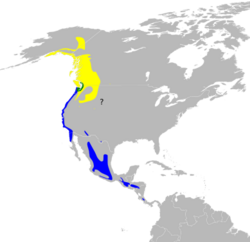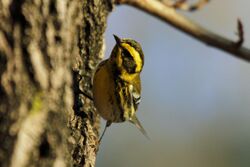Biology:Townsend's warbler
| Townsend's warbler | |
|---|---|

| |
| Scientific classification | |
| Domain: | Eukaryota |
| Kingdom: | Animalia |
| Phylum: | Chordata |
| Class: | Aves |
| Order: | Passeriformes |
| Family: | Parulidae |
| Genus: | Setophaga |
| Species: | S. townsendi
|
| Binomial name | |
| Setophaga townsendi (Townsend, 1837)
| |

| |
| Range of S. townsendi Breeding range Year-round range Wintering range
| |
| Synonyms | |
|
Sylvia townsendi (protonym) | |
Townsend's warbler (Setophaga townsendi) is a small songbird of the New World warbler family.
Taxonomy
Townsend's warbler was formally described in 1837 by the American naturalist John Kirk Townsend under the binomial name Sylvia townsendi.[2] The type locality is Fort Vancouver on the Columbia River in the state of Washington.[3] After the merger of the genera Dendroica and Setophaga,[4] Townsend's warbler is now placed in the genus Setophaga that was introduced by the English naturalist William Swainson in 1827.[5][6] The species is monotypic: no subspecies are recognised.[6]
Description
Townsend's warbler has a yellow face with a black stripe across its cheeks extending into an ear patch, a thin pointed bill, two white wing bars, olive upperparts with black streaks on their backs and flanks, and a white belly.[7] Adult males have a black cap, black throat and yellow lower breast; females have a dark cap and a yellow throat. Immature birds are similar to females with a dark green cap and cheeks.[8]

| Standard Measurements[9][8] | |
|---|---|
| length | 4.5–5 in (110–130 mm) |
| weight | 8.8 g (0.31 oz) |
| wingspan | 8 in (200 mm) |
| wing | 63.1–69.9 mm (2.48–2.75 in) |
| tail | 47.1–54 mm (1.85–2.13 in) |
| culmen | 9.9–10.8 mm (0.39–0.43 in) |
| tarsus | 18.1–19 mm (0.71–0.75 in) |
Life history

Their breeding habitats are coniferous forests with large trees on the northwestern coast of North America.[7] Their nests are shallow cups built with grass and lined with moss.[10] These nests are usually placed atop a branch in a conifer. The female lays 4 to 5 brown-speckled white eggs.[10]
This bird is closely related to the hermit warbler, and the two species interbreed where their ranges overlap.[8]
Birds from Haida Gwaii migrate short distances further south on the Pacific coast. Other birds winter in Mexico, Central America, and the south-western United States .[7]
They forage actively in the higher branches, often gleaning insects from foliage and sometimes hovering or catching insects in flight.[11] They mainly eat insects and spiders and seeds. Outside of the nesting season, these birds forage in mixed flocks. In winter, they also eat berries and plant nectar,[10] and honeydew directly from the anus of scale insects.[12]
The song of the male bird is a buzzed zee-zee-zee-bzz-zee or weazy weazy weazy weazy twea,[10] somewhat similar to that of its eastern relative, the black-throated green warbler.[8] The call is a sharp tup.
This bird was named after the American ornithologist, John Kirk Townsend.[2] Although Townsend is also credited with first describing this bird, he used a name chosen by Thomas Nuttall, who was travelling with him, and so sidestepped the convention against naming a species after oneself.[7]
References
- ↑ BirdLife International (2016). "Setophaga townsendi". IUCN Red List of Threatened Species 2016: e.T22721683A94723311. doi:10.2305/IUCN.UK.2016-3.RLTS.T22721683A94723311.en. https://www.iucnredlist.org/species/22721683/94723311. Retrieved 13 November 2021.
- ↑ 2.0 2.1 Townsend, John Kirk (1837). "Description of twelve new species of birds, chiefly from the vicinity of the Columbia River". Journal of the Academy of Natural Sciences of Philadelphia 7: 187–192 [191–192]. https://www.biodiversitylibrary.org/page/24676853.
- ↑ Paynter, Raymond A. Jr, ed (1968). Check-List of Birds of the World. 14. Cambridge, Massachusetts: Museum of Comparative Zoology. p. 26. https://www.biodiversitylibrary.org/page/14481227.
- ↑ Chesser, R. Terry; Banks, Richard C.; Barker, F. Keith; Cicero, Carla; Dunn, Jon L.; Kratter, Andrew W.; Lovette, Irby J.; Rasmussen, Pamela C. et al. (2011). "Fifty-Second Supplement to the American Ornithologists' Union check-list of North American Birds" (in en). The Auk 128 (3): 600–613. doi:10.1525/auk.2011.128.3.600.
- ↑ Swainson, William John (1827). "A synopsis of the birds discovered in Mexico by W. Bullock, F.L.S. and Mr. William Bullock jun.". Philosophical Magazine. New Series 1: 364–369 [368]. doi:10.1080/14786442708674330. https://biodiversitylibrary.org/page/15530378.
- ↑ 6.0 6.1 Gill, Frank; Donsker, David; Rasmussen, Pamela, eds (2020). "New World warblers, mitrospingid tanagers". IOC World Bird List Version 10.2. International Ornithologists' Union. https://www.worldbirdnames.org/bow/warblers/.
- ↑ 7.0 7.1 7.2 7.3 Wright, A. L.; Hayward, G. D.; Matsuoka, S. M.; Hayward, P. H. (2020-03-04). Rodewald, P. G.. ed. Birds of the World. Cornell Lab of Ornithology. doi:10.2173/bow.towwar.01. https://birdsoftheworld.org/bow/species/towwar/cur/introduction. Retrieved 2022-10-21.
- ↑ 8.0 8.1 8.2 8.3 Sibley, David Allen (2000). The Sibley Guide to Birds. New York: Knopf. p. 438. ISBN 0-679-45122-6. https://archive.org/details/sibleyguidetobir00sibl_0/page/438.
- ↑ Godfrey, W. Earl (1966). The Birds of Canada. Ottawa: National Museum of Canada. p. 331.
- ↑ 10.0 10.1 10.2 10.3 "Townsend's Warbler" (in en). 2014-11-13. https://www.audubon.org/field-guide/bird/townsends-warbler.
- ↑ Rich, Terrell D.; Dobkin, David S. (1996). "Conservation and Management of Neotropical Migrant Landbirds in the Northern Rockies and Great Plains". The Journal of Wildlife Management 60 (1): 209. doi:10.2307/3802059. https://www.jstor.org/stable/3802059.
- ↑ Greenberg, Russell; Caballero, Claudia Macias; Bichier, Peter (1993). "Defense of Homopteran Honeydew by Birds in the Mexican Highlands and Other Warm Temperate Forests". Oikos 68 (3): 519. doi:10.2307/3544920. Bibcode: 1993Oikos..68..519G. https://www.jstor.org/stable/3544920.
External links
- "Townsend's warbler media". Internet Bird Collection. http://www.hbw.com/ibc/species/townsends-warbler-dendroica-townsendi.
- Townsend's warbler species account - Cornell Lab of Ornithology
- Townsend's warbler - Dendroica townsendi - USGS Patuxent Bird Identification InfoCenter
- Townsend's warbler photo gallery at VIREO (Drexel University)
Wikidata ☰ Q512543 entry
 |


